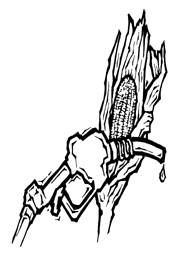 |
 |
 |
 |
 |
 |
David explores how we can fuel cars with corn.
Segment Length: 7:15
Ethanol
Show Number 1412
What is ethanol and
how does it make a car run?
What are renewable resources
and why are they important?
![]() Getting Started
Getting Started
Research fuel consumption figures for city or school buses. Compare the bus efficiency to a Ford Taurus with a 31 mile-per-gallon rating. If the Ford Taurus carries four passengers, then it gets 124 passenger-miles per gallon. If it carries just one passenger, it gets only 31 passenger-miles per gallon. How many passengers does a bus have to carry to become more efficient than using individual cars for transportation?
What kind of gasoline does your family put in your car? Does it contains any additives? Do you think the additives make a difference in how the car runs? Do they make a difference in the amount of pollution cars produce?
As the number of people in the world keeps growing, so does our need for energy. Some energy sources, specifically fossil fuels like coal and oil, are in limited supply. Once we use up what's in the ground, they will be gone forever. Other energy sources, such as wind, water power, and solar energy, are called renewable energy, because they will regenerate over and over again as we use them.
Ethanol is one form of renewable energy that is becoming widely used. Ethanol is a form of alcohol that can be burned in engines just like gasoline. But unlike gasoline, which is made by distilling crude oil, ethanol is made from the starchy parts of plants. Most ethanol in this country is created through fermentation of corn. Microscopic yeast cells break down the starch and water, creating ethanol and carbon dioxide gas.
In addition to being a renewable fuel, ethanol helps to reduce air pollution. When anything burns in air, molecules of that substance combine with oxygen. Gasoline is a substance made of carbon and hydrogen. When it burns, some, but not all, of the carbon atoms combine with oxygen to make carbon dioxide(CO2). Hydrogen in the gasoline combines with more of the air's oxygen to make water (H2O). There isn't enough oxygen left to combine with the remaining carbon atoms. Deadly carbon monoxide gas (CO) is the result. Like gasoline, ethanol is made of carbon and hydrogen, but in addition it contains its own supply of oxygen. When ethanol burns with gasoline, its "extra" oxygen atoms combine with the "extra" carbon atoms to reduce or even eliminate CO in the exhaust gases.
In some parts of the U.S., ethanol is mixed with gasoline at 1 part ethanol to 9 parts gasoline to help reduce air pollution. No adjustment is needed for a car's engine to burn this mixture. Some new cars are designed to burn fuel blends of up to 80 percent ethanol.
Ethanol costs more to make than gasoline. New production technologies may bring the price of ethanol down in the coming years.
Another disadvantage is that a gallon of ethanol doesn't hold as much chemical energy as a gallon of gasoline. So even though ethanol burns more cleanly than gasoline, a car won't go as many miles per gallon.
Gay, K. (1991) Air pollution. New York: Franklin Watts.
Gromer, C. (1993, Apr) Flex-fuel Dodge Spirit. Popular Mechanics, p. 176.
Homewood, B. (1993, Jan 9) Will Brazil's cars go on the wagon? New Scientist,
pp. 22 - 23.Morris, D. & Lorenz, D. How much energy does it take to make a gallon of ethanol? (rev 1995) Minneapolis: Institute for Local Self Reliance Web site:
http://www.ilsr.orgAlternative fuel vehicles:
http://www.energy.ca.gov/energy/cectext/AlterVehicle.htmlBiofuels information network:
http://www.esd.ornl.gov/BFDP/BFDPMOSAIC/binmenu.htmlBiomass:
http://www.nrel.gov/research/industrial_tech/biomass.htmlBiomass Energy Alliance:
http://www2.biomass.org/
Student Activity:
Ethanol

Stirring up a Storm
Discover the best food to ferment.
What kinds of foods are easiest to ferment for fuel? Ethanol is made from a variety of plant substances - corn, sugar cane, even some kinds of wood. In this activity, you will test different substances to see what you can learn about fermentation.
Materials
Part One - Fermenting Foods
Questions
Part Two - Changing Temperatures
Questions
![]()
List all of the objects in your home (or school) that use purchased energy
inputs. Remember appliances that you may not see, such as water heaters.
How is each object powered? What fuel is burned to produce the power?
![]()
Collect new car brochures. Compare EPA mileage figures and prices for each.
Use the price of gasoline to figure out which car will cost more over a
five-year period, based only on the purchase price of the car and cost
of gasoline to drive it 15,000 miles per year.
![]()
Assume that a 1995 Ford Taurus gets 30.9 miles per gallon on a mixture
of 10 percent ethanol and 90 percent gasoline, and only 23.1 miles per
gallon with a mix of 85 percent ethanol to 15 percent gasoline. If pure
gasoline costs $1.25 per gallon, how cheap must ethanol be to make the
cost per mile the same for both mixtures?
Tapes of this episode of Newton's Apple and others are available
from GPN for only $24.95.
Please call 1-800-228-4630.
For information on other Newton's Apple resources for home and school,
please call 1-800-588-NEWTON!
 We encourage duplication for educational non-commercial use.
We encourage duplication for educational non-commercial use.